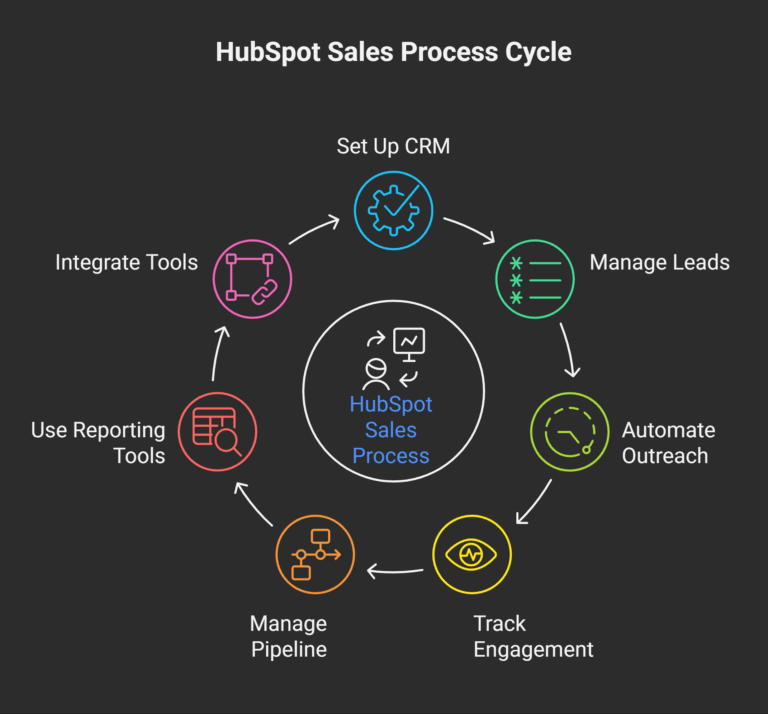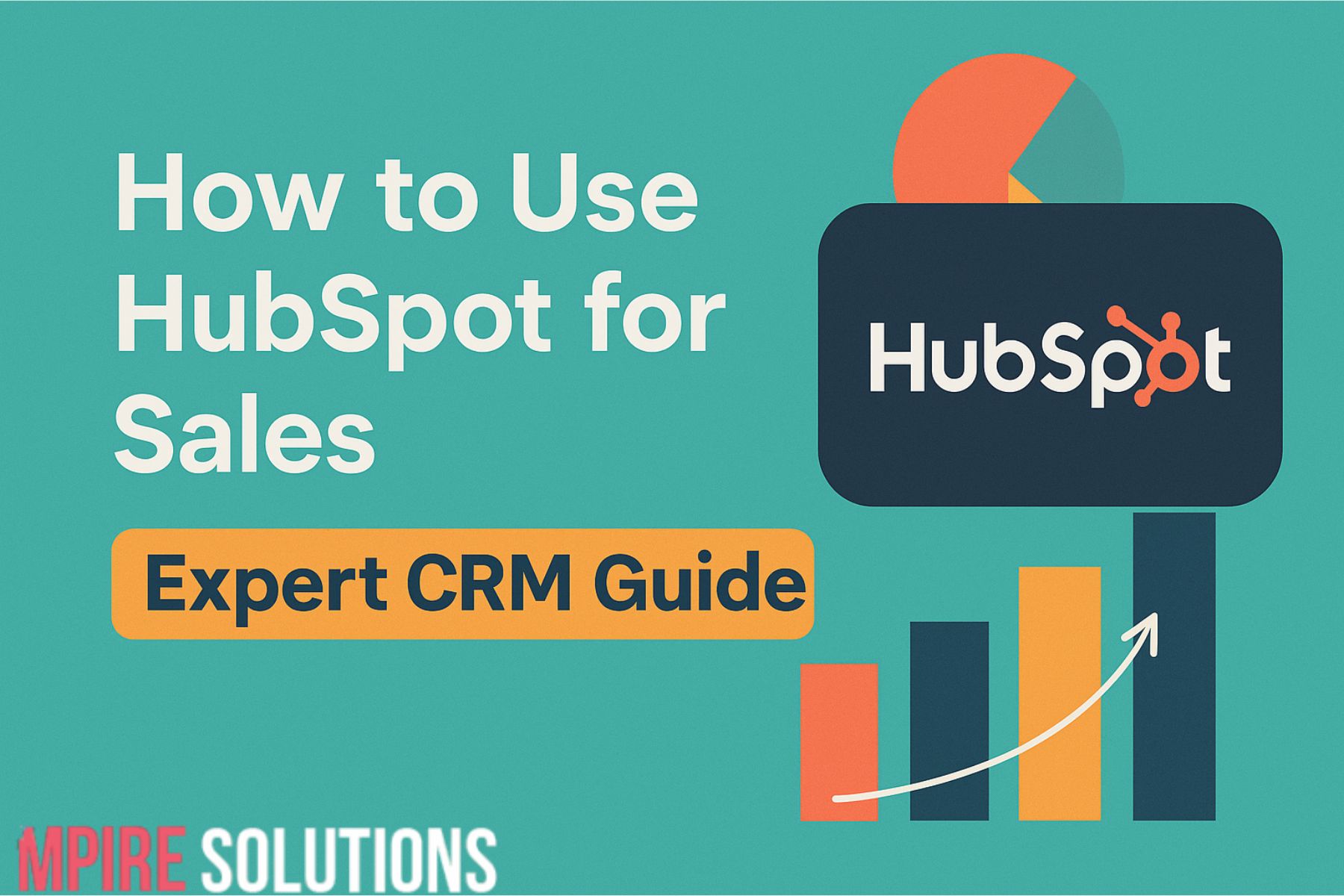How to Use HubSpot for Sales – A Complete Guide for Growing Revenue
Leveraging HubSpot effectively can transform your sales process from a manual, time-consuming effort into a streamlined, data-driven operation. As a certified HubSpot consultant with over 15 years of experience, I’ve helped businesses maximize this powerful platform to manage leads, track opportunities and improve closing rates. If you’re considering a HubSpot Sales Hub Implementation to enhance your CRM workflows, understanding the practical steps on how to use HubSpot for sales is crucial.
This guide walks you through actionable ways to utilize HubSpot’s CRM tools from prospecting and pipeline management to automation and reporting so your sales team can work smarter, not harder.
Why HubSpot is a Game-Changer for Sales Teams
HubSpot is more than just a contact database. It’s a complete sales enablement ecosystem that brings together lead management, email tracking, pipeline visualization and revenue forecasting—all in one platform. The key benefits include:
-
Centralized customer data accessible to the entire team.
-
Clear, visual pipelines for monitoring deals.
-
Built-in automation for repetitive sales tasks.
-
Real-time notifications for lead engagement.
-
Comprehensive reporting for decision-making.
Step-by-Step: How to Use HubSpot for Sales
1. Set Up Your HubSpot CRM for Sales Success
Before diving into outreach, ensure your CRM settings are configured to support your sales process. This includes:
-
Importing Contacts & Companies: Use CSV uploads or integrations with email and marketing tools.
-
Defining Deal Stages: Customize pipelines to reflect your exact sales cycle.
-
Creating Custom Properties: Capture key details like budget, industry and lead source.
Pro Tip: The more accurately your CRM reflects your real-world sales process, the easier it will be to manage deals efficiently.
2. Master Contact & Lead Management
One of the most effective aspects of how to use HubSpot CRM for sales is organizing leads into targeted lists. You can:
-
Segment Leads: Based on industry, deal size or lifecycle stage.
-
Assign Owners: Ensure accountability by assigning each lead to a sales rep.
-
Log Activities: Keep track of every call, meeting and email to maintain a complete engagement history.
3. Automate Sales Outreach
HubSpot’s automation tools can handle repetitive tasks, allowing your sales reps to focus on closing deals.
-
Sequences: Automate follow-up emails and task reminders.
-
Workflows: Assign leads automatically based on predefined criteria.
-
Email Templates: Create pre-approved messages to maintain consistency.
4. Track Engagement in Real Time
HubSpot provides instant alerts when a lead opens an email, clicks a link or visits your website. This insight lets sales reps respond at the right moment, increasing conversion chances.
5. Manage Your Sales Pipeline
The pipeline dashboard is the heartbeat of sales in HubSpot.
-
Drag-and-Drop Interface: Move deals between stages visually.
-
Forecasting: Predict revenue based on deal probability.
-
Multiple Pipelines: Create separate pipelines for different products or markets.
6. Use HubSpot’s Reporting Tools
Data-driven sales teams outperform their competition.
-
Deal Stage Analysis: Identify bottlenecks.
-
Activity Reports: Measure outreach effectiveness.
-
Revenue Reports: Track closed-won deals and sales growth trends.
7. Integrate with Other Sales Tools
HubSpot integrates with email platforms, calling software and proposal tools, allowing your sales team to operate from one hub. Examples include Zoom, Gmail, Outlook and LinkedIn Sales Navigator.

Advanced Tips for Power Users
-
Lead Scoring: Prioritize prospects most likely to convert.
-
Playbooks: Standardize your sales process for training new reps.
-
Custom Dashboards: Give each rep and manager a tailored performance view.
Common Mistakes to Avoid
-
Adding incomplete or outdated contact information.
-
Failing to follow up promptly after engagement alerts.
-
Ignoring the reporting dashboard, which can highlight critical sales trends.
Conclusion
Knowing how to use HubSpot for sales is about more than just learning the features it’s about aligning the platform with your specific sales strategy. Whether you’re just starting with the CRM or refining your current processes, optimizing your setup can lead to measurable improvements in lead conversion and revenue growth. If you need expert guidance on HubSpot Sales Hub, partnering with experienced consultants can help you fully leverage its capabilities.
FAQs
1. What is the first step in learning how to use HubSpot for sales?
Start by configuring your CRM with accurate contact data, deal stages and custom properties that match your sales process.
2. How can I use HubSpot CRM for sales automation?
You can create sequences for follow-ups, workflows for lead assignment and templates for consistent outreach.
3. Does HubSpot track sales emails in real time?
Yes, HubSpot notifies you instantly when a lead opens your email or clicks a link.
4. Can I manage multiple sales pipelines in HubSpot?
Absolutely. You can create and customize multiple pipelines for different products or markets.
5. Is HubSpot suitable for small sales teams?
Yes. Its flexibility and automation features make it ideal for teams of all sizes.
Relevant Guide
How to Get the Most Out of HubSpot – Expert Tips
Can You Populate HubSpot from Google Mail Contacts? Step by Step Guide
The Ultimate Guide to Shopify Order Sync HubSpot in 2025
HubSpot White Label Partner
HubSpot Managed Services
HubSpot Xero
 HubSpot Consulting Needs
HubSpot Consulting Needs  Custom Automation Plan
Custom Automation Plan 






